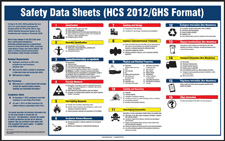| The Home page of ILPI's Safety Data Sheet (SDS) Resource, the leader in SDS information since 1995! | |
| The history and philosophy behind this resource. | |
| A curated collection of books and reference materials concerning Safety Data Sheets and closely related topics. | |
| Paste your plain text SDS into the SDS-Demystifier, and it will be converted into a hypertext-enriched document with links to detailed explanations of each key term. | |
| An extensive list of frequently asked questions about Safety Data Sheets including regulations, content, compliance, and more. | |
| A humorous take on Safety Data Sheet jargon. Fill in the blanks on our entry form to generate a personalized Unsafety Data Sheet to share with your coworkers. | |
| Since 1995, we've maintained this massive curated list of the best places to find Safety Data Sheets on the Internet. | |
| You are here! Way more than a glossary, this hypertext-enhanced resource covers hundreds of SDS-related terms and expert knowledge. Each entry includes both the SDS relevance and links to additional authoritative resources. | |
| Archived results of Safety Data Sheet related polls taken by some of our millions of site visitors | |
| The OSHA regulations behind SDS regulations, including the inspection guidelines and over 400 official interpretations letters under the Hazard Communication Standard | |
| Commercial suppliers of SDS authoring and management software as well as cloud compliance services. | |
| Commercial companies that will create SDS's for your specific needs as well as SDS translation companies. |

Safety signs, banners, and scoreboards? Get yours at Safety Emporium!
Definition
- Catharsis is the emptying, cleansing, purging or evacuation of the bowels (intestines).
- A cathartic or purgative is an agent that causes catharsis and is more commonly known as a laxative (a cathartic taken to relieve constipation).
Further Information

Safety Emporium carries biohazardous waste cans, labels, training materials and more...
Cathartics may be broken down into several different categories:
- Bulk cathartics stimulate evacuation of the bowel by increasing the bulk of the feces (stool). Examples include psyllium husk (the active ingredient in Metamucil®), methylcellulose (the active ingredient in Citrucel®) and dietary fiber such as wheat and oat bran.
- Lubricant or emollient cathartics soften the feces and reduce friction between the stool and the intestinal wall. Examples include mineral oil, docusate sodium (marketed as Surfak® and Colace®), and glycerin (as suppositories).
- Osmotic cathartics increases the water content and weight of the feces using the principle of osmosis. These can be further subdivided into two categories:
- Saline cathartics - Examples include magnesium citrate, magnesium sulfate, sodium sulfate, and magnesium hydroxide (Phillips Milk of Magnesia®).
- Disaccharides - An example is sorbitol which increases stool bulk through fermentation in the bowel. Free tip: don't eat too much sugarless candy containing this artificial sweetner...
- Stimulant cathartics cause wavelike muscular contractions around the intestines (peristalsis) that expel the contents. A common example used to be phenolphthalein, but this was banned for use as a laxative in 1997 because of the remote possibility that it was cancer-causing. A currently available example is bisacodyl (the active ingredient in Dulcolax®). Stimulants are much faster acting, harsher, and more likely to cause laxative dependency than the other types of laxatives.
- Combination agents work through one or more of the above mechanisms.

Ensure your workers are trained with safety posters and more at Safety Emporium.
Books Available
NOTE: We may collect a share of sales or other compensation from the links in the following list:
- "Poisoning and Toxicology Handbook, Fourth Edition", Hardcover, 1,384 pages, 2007. Estimated price $190.00. Info and/or order.
- "Poisoning & Drug Overdose, Eighth Ed", Paperback, 784 pages, 2022. Estimated price $62.08. Info and/or order.
- "Basic Concepts in Medicinal Chemistry 3rd Edition", Paperback, 2022, 544 pages. Estimated price $74.00. Info and/or order.
- "Principles of Forensic Toxicology 5th ed", Hardcover, 2020, 704 pages. Estimated price $72.09. Info and/or order.
SDS Relevance
You will generally find the term cathartic or catharsis on a Safety Data Sheet in reference to:
In Section 4 (first-aid measures) as a first aid measure to treat ingestion of the substance. Cathartics can decrease the absorption of substances in the gastrointestinal tract by accelerating the expulsion of the poison from the body. This may be a preferred method when the material involved is a caustic - for example, instead of inducing vomiting which would cause additional damage to the esophagus and throat.
The decision to utilize a cathartic in a poisoning situation should be made by a qualified medical professional only. There are other ways of reducing the absorption of toxic materials in the body; see the additional terms at the bottom of this page and Further Reading below.
In Section 11 (toxicological information) as a symptom of exposure, usually through ingestion of the material.
Further Reading

Hold on to your reaction with laboratory clamps and accessories from Safety Emporium.
- America's Poison Centers or, in an emergency, call (800) 222-1222.
- Family Practice Notebook has concise entries on Cathartics as well as Osmotic Laxatives and more with a particular emphasis on their use and contraindications (i.e. when not to use) them in emergency medicine.
- Google Books has an excerpt from Comprehensive Review in Toxicology for Emergency Clinicians that discusses cathartics and other methods of preventing absorption of toxins.
- Toxic Trivia has a question that includes phenolphthalein.
- Cathartic and Laxative Drugs (Monogastric) from the Merck Veterinary Manual Professional Version.
- The Annals of Emergency Medicine discusses Clinical Policy for the Initial Approach to Patients Presenting With Acute Toxic Ingestion or Dermal or Inhalation Exposure in Volume 33, Number 6, June 1999. The conclusions generally favor activated charcoal over cathartics. A subscription is required unless you access it from an school, library etc. that has a site license.
See also: activated charcoal, antidote, emesis, gastric, poison.